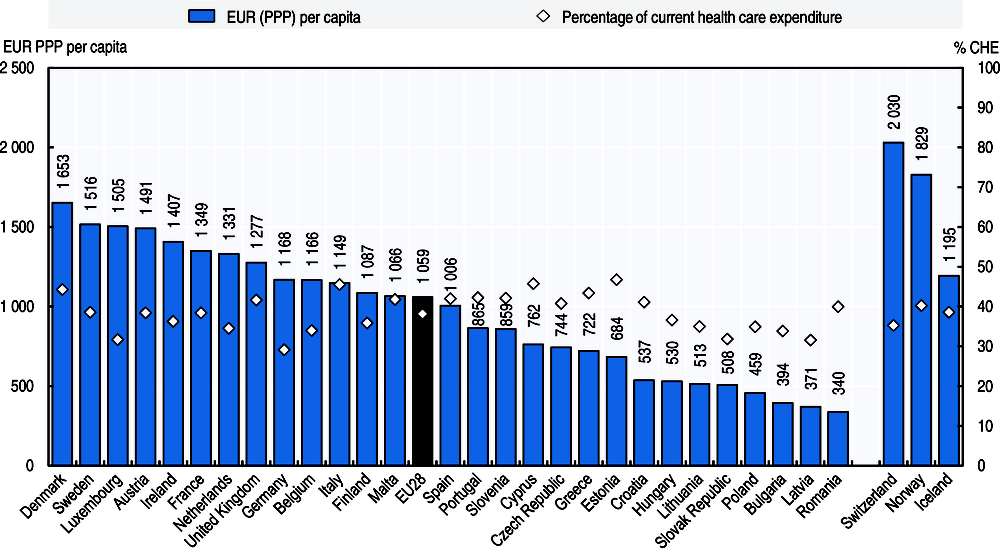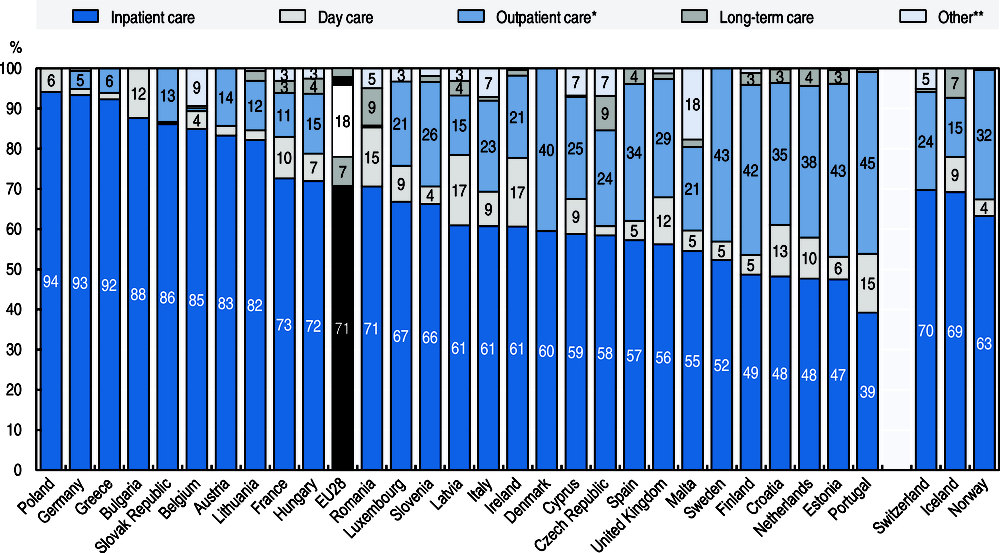Health expenditure in hospitals
Breaking down health spending by provider offers an organisational perspective, by identifying the setting in which different health services are delivered. Care can be provided in a variety of institutions, ranging from hospitals and medical practices, to pharmacies, care homes and even private households caring for family members.
Hospitals have traditionally been the key health care provider, in terms of their share of health spending. In 2016, health services in hospitals accounted for nearly two-fifths of all EU health expenditure and represented the largest spending category for most EU countries. In Estonia, Cyprus and Italy almost half of health care expenditure related to hospital services. In contrast, in Germany a greater proportion of health services are provided in ambulatory settings and, by consequence, hospital services in Germany accounted for less than 30% of health spending, the lowest share in the EU. Part of the variation in the share of hospital spending can also be attributed to the provision of outpatient pharmaceuticals, with hospital pharmacies playing a larger role in some countries than in others.
While expenditure on hospital services varies considerably between EU member states, it tends to be in line with overall health care expenditure, with high-income countries spending the most. Overall, EU countries spent EUR 1 059 per person on hospitals in 2016. Spending was highest in Denmark at EUR 1 653 per person, and was more than EUR 1 500 per capita in Luxembourg and Sweden (Figure 5.8). By comparison, spending on hospitals in Romania accounted for less than EUR 350 per person and was at a similar level for Latvia, Bulgaria and Poland.
While the types of care delivered in hospital settings differ across EU countries (Figure 5.9), inpatient and outpatient care remain the most common services provided. In 2016, spending on inpatient curative and rehabilitative care accounted for at least half of all hospital expenditure for the majority of EU countries and more than 90% in Poland, Germany and Greece. This high share is due, to a large extent, to the use of alternative settings for care delivery; for example, specialised outpatient services delivered in ambulatory centres or private practices in Germany (Busse and Blümel, 2014). The share of hospital inpatient care is lowest in Portugal, Estonia, the Netherlands, Croatia and Finland, where hospital outpatient services play a much greater role.
The share of hospital spending on day care services has generally been increasing in most EU countries. This often reflects an explicit policy to generate efficiency gains and reduce hospital waiting times (OECD, 2017). Moreover, for some interventions, guidelines advise that day care procedures are the most appropriate treatment method. For all EU countries, inpatient and day care services together account for at least half of hospital spending.
Hospitals can also be important providers of outpatient care, for example through accident and emergency departments, hospital-based specialist outpatient units, or laboratory and imaging services provided to outpatients. Outpatient care accounted for 45% of hospital spending in Portugal, and more than 40% in Sweden, Estonia, Finland and Denmark. On the other hand, in Poland, Bulgaria, Romania, Belgium, Germany and Greece, less than 10% of hospital expenditure goes on outpatient care.
The classification of health care providers is defined in the System of Health Accounts (OECD, Eurostat and WHO, 2017) and encompasses primary providers, i.e. organisations and actors that deliver health care goods and services as their primary activity, as well as secondary providers, for which health care provision is only one among a number of activities.
The main categories of primary providers are hospitals, residential long-term care facilities, ambulatory providers (e.g. offices of general and specialised physicians, dental practices, ambulatory health care centres), providers of ancillary services (e.g. ambulance services), retailers (e.g. pharmacies), and providers of preventive care (e.g. public health institutes).
Secondary providers include, for example, supermarkets that sell over-the-counter medicines, or facilities that provide health care services to a restricted group of the population such as prisons or police health services. Secondary providers also include providers of health care system administration and financing (e.g. government agencies, health insurance agencies) and households as providers of home health care.
Differences can exist in the administering and dispensing of pharmaceuticals to outpatients in hospitals. Some countries have a larger range of pharmaceuticals dispensed in hospital outpatient settings, which should be considered when comparing overall hospital spending. In addition, some of these costs may erroneously be accounted under curative care rather than under pharmaceuticals.
References
Busse, R. and M. Blümel (2014), “Germany: Health system review”, Health Systems in Transition, Vol. 16/2, www.euro.who.int/__data/assets/pdf_file/0008/255932/HiT-Germany.pdf?ua=1.
OECD (2017), Tackling Wasteful Spending on Health, OECD Publishing, Paris, https://doi.org/10.1787/9789264266414-en.
OECD/Eurostat/WHO (2017), A System of Health Accounts 2011: Revised edition, OECD Publishing, Paris, https://doi.org/10.1787/9789264270985-en.


